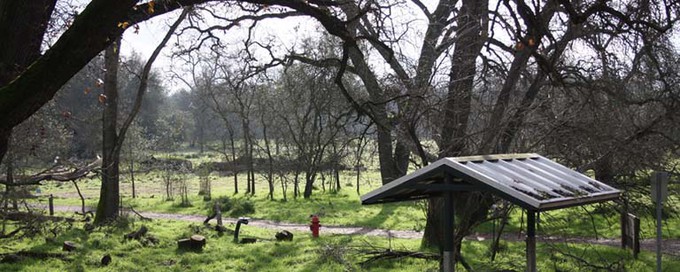
Effie Yeaw Nature Center in Carmichael hosts guided experience

Get outdoors in nature for a walk specifically designed to de-stress the walkers. Courtesy Effie Yeaw Nature Center
Feeling stressed? A walk in nature is a proven way to help ease tension and lower stress levels. Mother Nature is good for you; gardens in general can help you feel more relaxed.
Get in touch with nature while lowering your blood pressure during a special Nature and Forest Therapy Walk at 8 a.m. Saturday, Oct. 15, at Effie Yeaw Nature Center in Carmichael.
Nature and forest therapy guide Jane McCluskey will lead the way.
“The forest provides more than we typically perceive,” she says. “Have you caught yourself day dreaming as you look out a window? Caught yourself laughing with baby animal videos? Forest therapy walks are not nature hikes and not meditation retreats. Drawing from old traditions and relatively new findings, nature and forest walks are brief immersions into something you create with nature.
“Forest therapy walks are slow journeys through an area populated by natural life,” she explains. “We cannot tell you what you will experience; we can only tell you what we will be doing in these guided visits. We sometimes walk, sometimes we touch the earth, sometimes we sit and sometimes we do something different.”
This is not about exercise, she adds, but experiencing nature on a personal level.
At Effie Yeaw Nature Center, there’s plenty of nature to experience. Located close to the American River, the center reserves a slice of nature now surrounded by suburbia. See native oaks and the wildlife that make those trees their home. Explore the center’s picturesque plantings, designed with bees and butterflies in mind.
Fee is $35; advance registration is required. Additional Therapy Walks are planned for Nov. 12 and Dec 3. Effie Yeaw Nature Center is located at 2850 San Lorenzo Way, Carmichael.
Details and registration: https://www.sacnaturecenter.net/event/fall-nature-forest-therapy-walks/ or 916-489-4918.
Comments
0 comments have been posted.Sacramento Digs Gardening to your inbox.
Sites We Like
Garden Checklist for week of April 14
It's still not warm enough to transplant tomatoes directly in the ground, but we’re getting there.
* April is the last chance to plant citrus trees such as dwarf orange, lemon and kumquat. These trees also look good in landscaping and provide fresh fruit in winter.
* Smell orange blossoms? Feed citrus trees with a low dose of balanced fertilizer (such as 10-10-10) during bloom to help set fruit. Keep an eye out for ants.
* Apply slow-release fertilizer to the lawn.
* Thoroughly clean debris from the bottom of outdoor ponds or fountains.
* Spring brings a flush of rapid growth, and that means your garden needs nutrients. Fertilize shrubs and trees with a slow-release fertilizer. Or mulch with a 1-inch layer of compost.
* Azaleas and camellias looking a little yellow? If leaves are turning yellow between the veins, give them a boost with chelated iron.
* Trim dead flowers but not leaves from spring-flowering bulbs such as daffodils and tulips. Those leaves gather energy to create next year's flowers. Also, give the bulbs a fertilizer boost after bloom.
* Pinch chrysanthemums back to 12 inches for fall flowers. Cut old stems to the ground.
* Mulch around plants to conserve moisture and control weeds.
* From seed, plant beans, beets, cantaloupes, carrots, corn, cucumbers, melons, radishes and squash.
* Plant onion sets.
* In the flower garden, plant seeds for asters, cosmos, celosia, marigolds, salvia, sunflowers and zinnias.
* Transplant petunias, zinnias, geraniums and other summer bloomers.
* Plant perennials and dahlia tubers for summer bloom.
* Mid to late April is about the last chance to plant summer bulbs, such as gladiolus and tuberous begonias.
* Transplant lettuce seedlings. Choose varieties that mature quickly such as loose leaf.